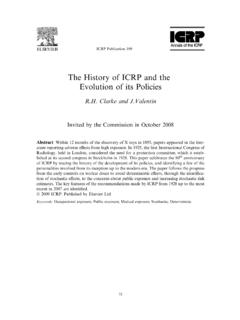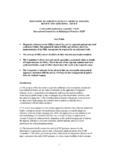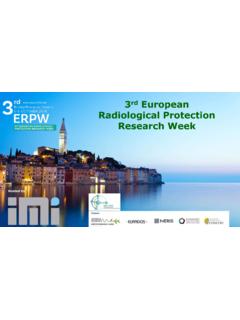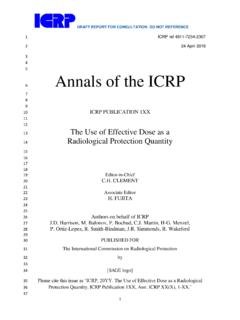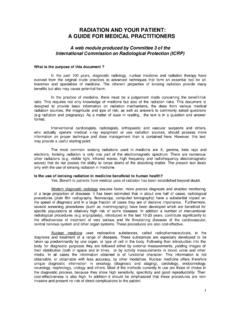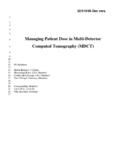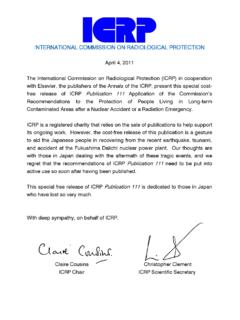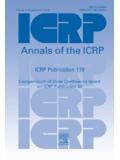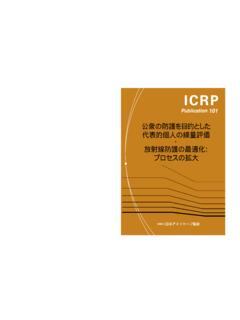Transcription of Minimizing Medically Unwarranted CT Scans - ICRP
1 Minimizing Medically Unwarranted CT Scans David J. Brenner Columbia University Medical Center, New York, NY The big issue with CT doses The individual radiation risks from CT are small, but almost certainly non zero, so if a CT scan is Medically justified, the benefit / risk ratio for any individual will typically be very large But ~ of all CTs may be clinically unjustified (~20 million /yr in the US), and here the benefit /risk ratio will not be large For these clinically unjustified CT Scans , even though the individual radiation risk will still be very small, when multiplied by a large (and increasing) number of individuals (~20 million/yr in the US)
2 , the potential exists to produce a significant long-term public health concern We need to minimize Medically Unwarranted CT Scans a hard task The big issue with CT doses The individual radiation risks from CT are small, but almost certainly non zero, so if a CT scan is Medically justified, the benefit / risk ratio for any individual will typically be very large But ~ of all CTs may be clinically unjustified (~20 million /yr in the US), and here the benefit /risk ratio will not be large For these clinically unjustified CT Scans , even though the individual radiation risk will still be very small, when multiplied by a large (and increasing) number of individuals (~20 million/yr in the US), the potential exists to produce a significant long-term public health concern We need to minimize Medically Unwarranted CT Scans a hard task Typical organ doses from single diagnostic x ray examinations Examination Relevant organ Relevant organ dose (mGy) Dental x ray Brain PA Chest x ray Lung Lateral chest x ray Lung Screening mammogram Breast 3 Adult abdominal CT (200 mAs) Stomach 11 Adult head CT (200 mAs) Brain 13 Child abdominal CT (50 / 200 mAs) Stomach 8 / 30 Child head CT (100 / 200 mAs)
3 Brain 18 / 35 Taking onto account * Machine variability, * Usage variability, * Age variability, * Scans done with and without contrast * Multiple Scans the relevant organ dose range for CT is 5 - 100 mSv The most likely organ dose range for CT Low dose radiation risks Hiroshima and Nagasaki 5-100 mSv Number of solid cancers in A-bomb survivors exposed to doses from 5-100 mSv 81 56 Radiation-related excess solid cancers4,3253,221 Solid cancers expected (controls)4,4063,277 Total solid cancers observed27,78931,650 Study population(5-100 mSv)Cancer incidence(1958-98)Cancer mortality (1950-97)81 56 Radiation-related excess solid cancers4,3253,221 Solid cancers expected (controls)4,4063,277 Total solid cancers observed27,78931,650 Study population(5-100 mSv)Cancer incidence(1958-98)Cancer mortality (1950-97)81 56 Radiation-related excess solid cancers4,3253,221 Solid cancers expected (controls)4,4063,277 Total solid cancers observed27,78931,650 Study population(5-100 mSv)Cancer incidence(1958-98)Cancer mortality (1950-97)81 56 Radiation-related excess solid cancers4,3253,221 Solid cancers expected (controls)4,4063,277 Total solid cancers observed27,78931,650 Study population(5-100 mSv)Cancer incidence(1958-98)
4 Cancer mortality (1950-97)Preston et al 2007 Small but statistically significant increase in risk Abdominal CT ScansFrom Wall (2004)UK 1998 US 2007 There is also an increasing realization that lifetime cancer risks due to radiation exposure in middle age may be larger than we thought Age distribution of CT Scans From Berrington de Gonzalez et al 2009 There is also an increasing realization that lifetime cancer risks due to radiation exposure in middle age may be larger than we thought 01020304050607080 Age at Exposure010002000300040005000 Lifetime attributable cancer risk per 106 individuals exposed to 10 mGyFemaleMaleFrom BEIR-VII (2006) BEIR400020000 20 40 60 80 Age at Exposure0 BEIR-VII Shuryak et al JNCI 2010 Estimating the radiation-induced cancer risks from CT exams Direct epidemiology on people who received CT Scans Risk estimation based on organ doses Estimated % lifetime attributable cancer mortality risk, as a function of age at exam, for a single CT exam 01020304050607080 Age at CT Examination (Years) Lifetime Attributable Risk (%)Adult: 200 mAs Pediatric Abdomen: 50 mAs Pediatric Head: 100 mAs There is no question that CT has revolutionized medical practice.
5 Has made it possible to examine a variety of abnormalities in the abdomen and thorax in a manner not previously possible. This development permits a remarkable insight into the study of human disease in vivo The big issue with CT doses The individual radiation risks from CT are small, but almost certainly non zero, so if a CT scan is Medically justified, the benefit / risk ratio for any individual will typically be very large But ~ of all CTs may be clinically unjustified (~20 million /yr in the US), and here the benefit /risk ratio will not be large For these clinically unjustified CT Scans , even though the individual radiation risk will still be very small, when multiplied by a large (and increasing) number of individuals (~20 million/yr in the US)
6 , the potential exists to produce a significant long-term public health concern We need to minimize Medically Unwarranted CT Scans a hard task Some common scenarios where there is evidence that CT usage could potentially be reduced, without compromising patient care CT for renal colic CT for minor head trauma CT for abdominal pain CT for abdominal and chest trauma CT angiography for pulmonary embolus 2001 Straw Poll of Pediatric Radiologists: 30% of CT Scans are not clinically necessary What proportion of CT Scans could potentially be avoided? There are many studies of the proportion of CT Scans that could be avoided if high-sensitivity CT decision guidelines are applied What proportion of CT Scans could potentially be avoided?
7 Retrospective analysis of decision guidelines for CT scanning of mild traumatic brain injury Decision Guideline (sensitivity for detecting surgical hematoma 99%) % of CT Scans that could be avoided Scandinavian 50 Nexus-II 44 New Orleans 31 WFNS 45 Canadian CT Head Rule 45 Glasgow coma scale 14-15, Stein et al 2009 Decision rules for diagnosing pediatric appendicitis v Equivocal symptoms CT Appendectomy + 100% CT v Ultrasound Equivocal symptoms Appendectomy CT + - + 70% CT Based on Garcia Pena 2004 Low Risk In patient observation Ultrasound Medium risk Appendectomy CT + - + High Risk ( Alvarado scoring system) Appendectomy 43% CT v v v Many sets of decisions rules exist, some good, some not so good Inappropriate CT prescriptions rates: Department of Radiology, Oulu University Hospital based on EC Referral Guidelines CT Exam Percent inappropriate Lumbar & central spine 77 Head 36 Abdomen / upper abdomen 37 Nasal sinus 20 Cervical spine 3 Trauma 0 All CT exams 30 Oikarinen et al 2009 Inappropriate CT prescriptions rates.
8 Primary care based on ACR Appropriateness Criteria CT Exam Percent inappropriate Head / brain 62 Maxillofacial 36 Spine 53 Chest 12 Chest/abdomen/pelvis 30 Abdomen / pelvis 18 Miscellaneous + angiography 21 All CT exams 27 Lehnert and Bree 2010 200 trauma patients studied, who had some radiation imaging 169 had CT Scans Total number of CTs: 660 Cost $837,000 Had ACR Appropriateness Criteria been 44% of CTs would not have been carried out None of the major injuries would have been excluded from CT imaging 11 minor injuries, none of which required follow up, would have been excluded from CT imaging 39% decrease in cost Percent of ED visits involving CT Larson et al 2011 Percent of ED visitsinvolving CTPercent of Emergency Room Visits that Involve a CT (US data)
9 The big issue with CT doses The individual radiation risks from CT are small, but almost certainly non zero, so if a CT scan is Medically justified, the benefit / risk ratio for any individual will typically be very large But ~ of all CTs may be clinically unjustified (~20 million /yr in the US), and here the benefit /risk ratio will not be large For these clinically unjustified CT Scans , even though the individual radiation risk will still be very small, when multiplied by a large (and increasing) number of individuals (~20 million/yr in the US), the potential exists to produce a significant long-term public health concern We need to minimize Medically Unwarranted CT Scans a hard task CT scanners / million population From OECD Health Data, 2007 CT scanners / million population (2007) Number of CT Scans / yr USA: 80 million ( / caput) Japan.
10 50 million ( / caput) The big issue with CT doses The individual radiation risks from CT are small, but almost certainly non zero, so if a CT scan is Medically justified, the benefit / risk ratio for any individual will typically be very large But ~ of all CTs may be clinically unjustified (~20 million /yr in the US), and here the benefit /risk ratio will not be large For these clinically unjustified CT Scans , even though the individual radiation risk will still be very small, when multiplied by a large (and increasing) number of individuals (~20 million/yr in the US), the potential exists to produce a significant long-term public health concern We need to minimize Medically Unwarranted CT Scans a hard task Targeting this one quarter is a very hard task Physicians are subject to significant pressures Throughput Legal Economic From patients A significant fraction of CT Scans (at least ?)
